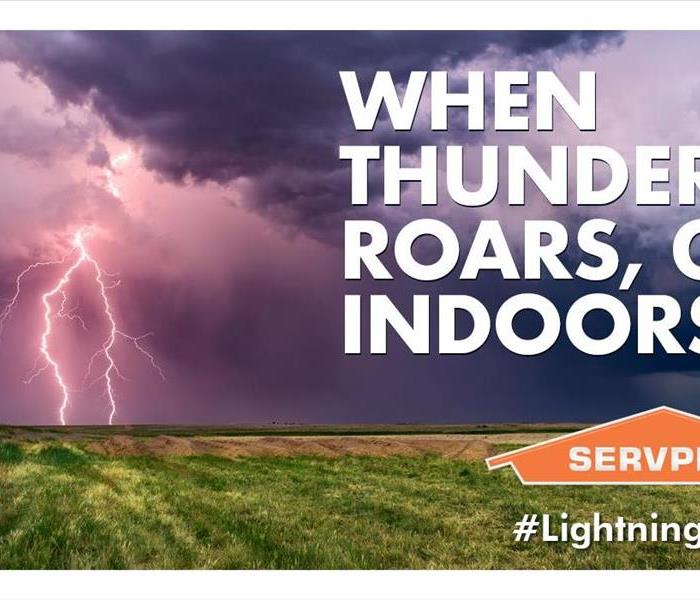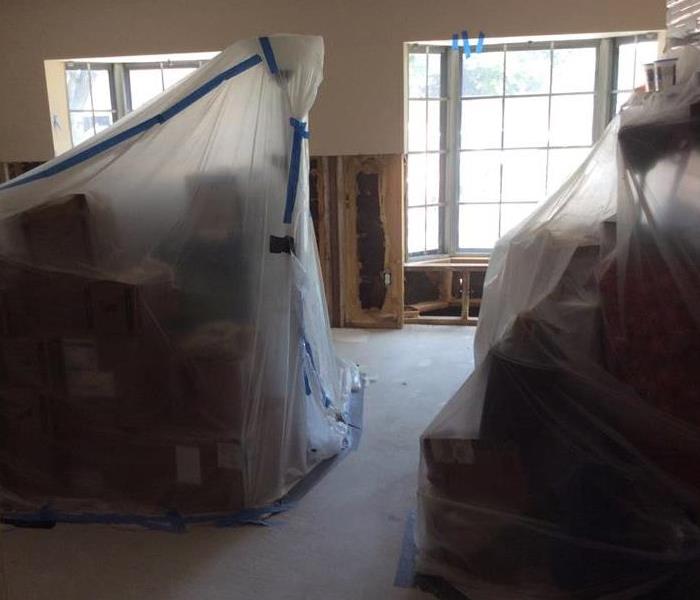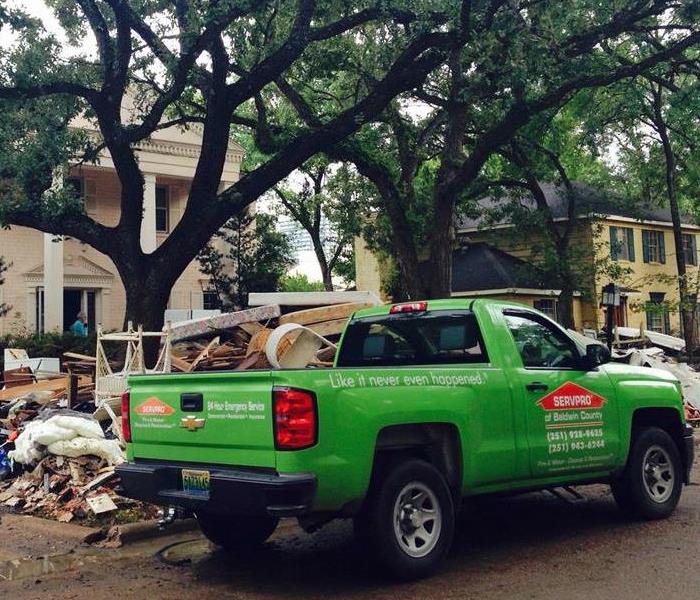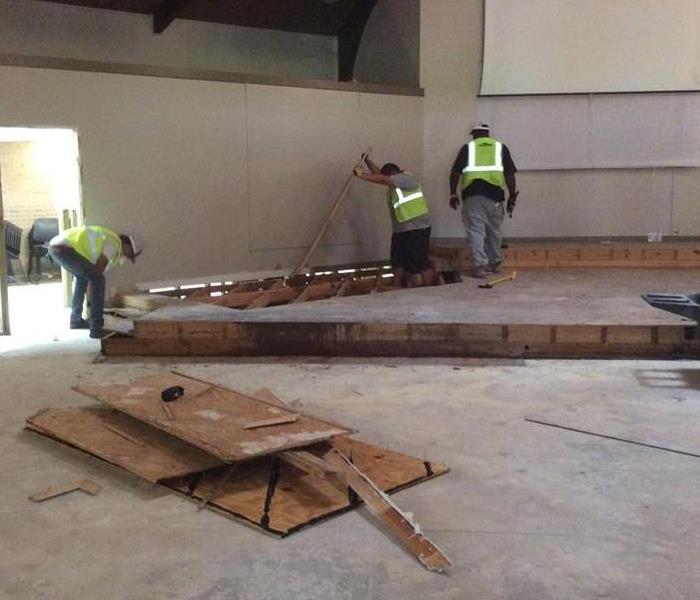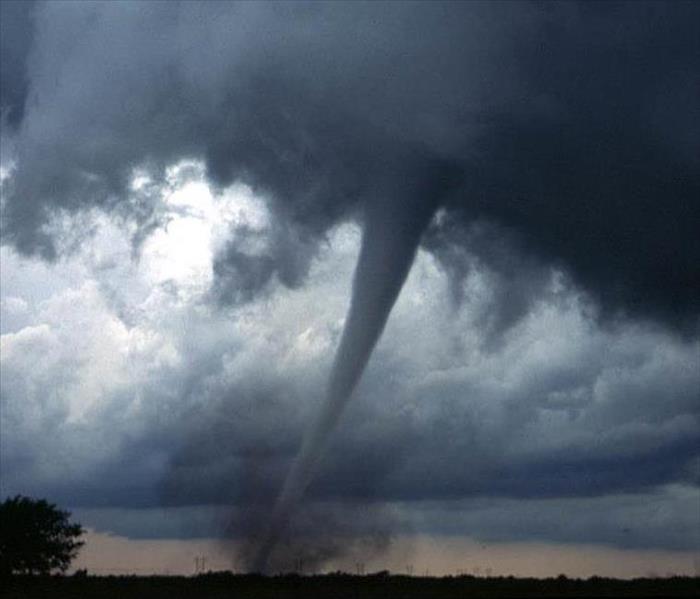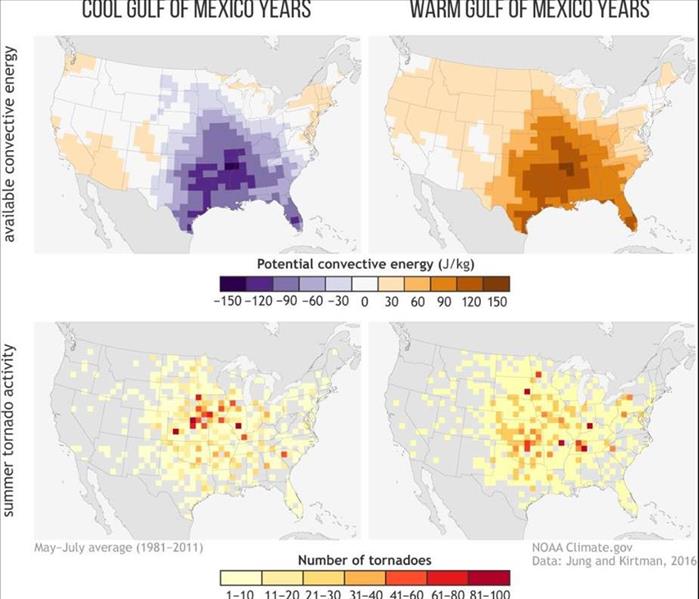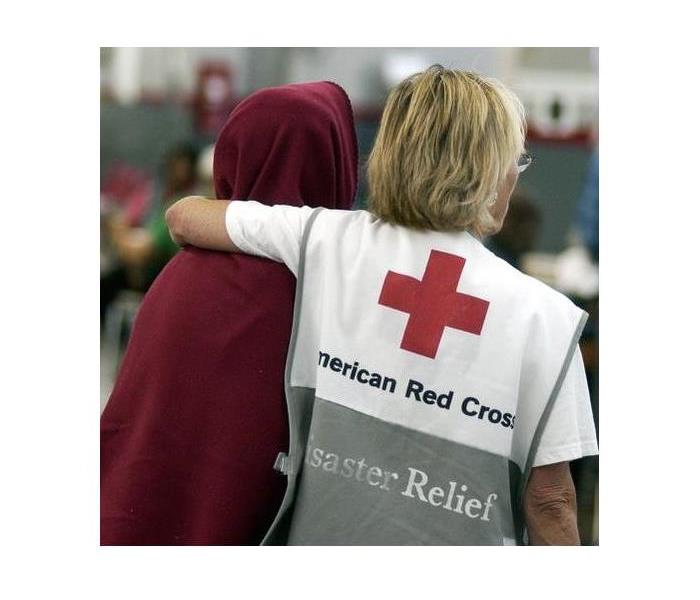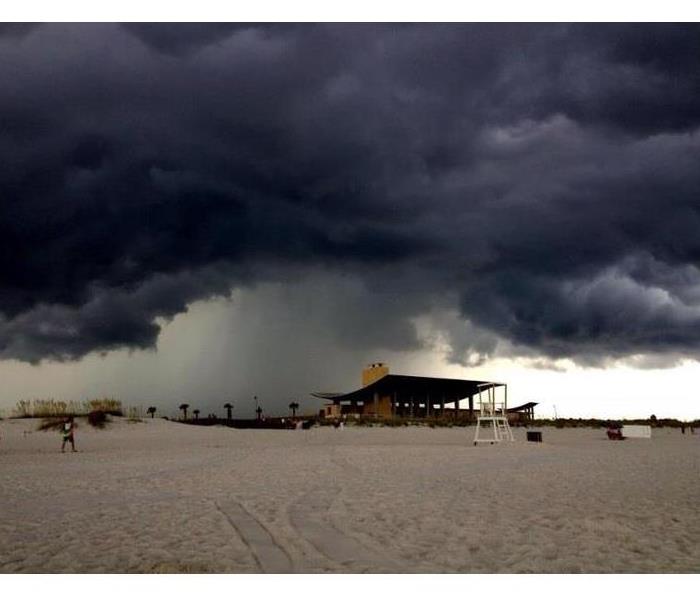Recent Storm Damage Posts
Water Damage in Antique Store
10/18/2023 (Permalink)
Our client recently experienced a damage at their retail business. This store is renowned for its unique collection of vintage furniture, rare collectibles, and one-of-a-kind memorabilia that had been lovingly curated over the years. The business is a true gem in the heart of the community, attracting locals and tourists alike.
Daphne, like many towns along the Gulf Coast, is known for its beautiful bay views and warm, humid climate. However, it was precisely this climate that presented a constant challenge for these business owners.
One day this past summer, a heavy rainstorm passed through Daphne. While it wasn't unusual, this particular storm was different. It brought torrential downpours, with the raindrops seeming relentless in their determination to drench the town.
Inside the store, the owners watched as the rain pelted against the windows and roof. They had always been cautious about potential water damage, having installed a state-of-the-art drainage system around the building and maintained the roof diligently. However, the storm was proving to be fiercer than anyone could have anticipated.
As the rain continued to pour, water began seeping in through the roof and around the windows. The owners rushed to move their priceless antiques to higher ground, desperately trying to protect their beloved inventory. But, despite their best efforts, some items were already damaged, and the water continued to infiltrate the store.
Panicked and overwhelmed, the owners called SERVPRO of Baldwin County for help. Our team arrived promptly and we immediately began combatting the water damage. We began extracting the inches of standing water that had spread throughout the 8,000 square foot building. As the hours passed, the storm began to subside and the water damage was brought under control. We placed large air movers and dehumidifiers to help with the drying process and tarped the roof. But, our client was left with a number of valuable antiques that were now in need of repair or restoration. It was a heartbreaking sight for a family that had poured their heart and soul into the business for decades.
The community rallied around the owners, offering their support in the days and weeks that followed. SERVPRO of Baldwin County began repairing the property first with the water mitigation then with the building restoration and construction while we also began restoring the damaged antiques. The owners also took this opportunity to strengthen their store's defenses against future water damage, ensuring that their beloved business would remain resilient in the face of adversity.
In the end, the story of water damage at this business became a testament to the strength and unity of a small town like Daphne. The owners emerged from the ordeal with a renewed sense of determination, and their business has continued to thrive, becoming not just a treasure trove of antiques but a symbol of the resilience of a tight-knit community on the Alabama Gulf Coast.
Rainy Weather in Baldwin County
5/26/2022 (Permalink)
It has been a rainy week here in Baldwin County, Alabama! Our team has been busy responding to calls due to roof leaks, groundwater intrusions, and an unfortunate part of excessive rain, sewage backups.
Water Damage is Serious.
It's important to identify any potential openings for water intrusion before it happens. Although, identifying potential causes can be difficult until a damage actually occurs, there are some ways that you can be proactive that can have a serious impact on preventing damages.
- Roof Inspection: having your roof inspected (especially if it is an older roof and has weathered many storms!) is an important item in your toolkit for preventing water damage. Our area is not a stranger to bad weather including tornadoes, tropical storms, or hurricanes. Even if you may not experience water damage, regular roof maintenance can be especially helpful in reducing risk for future damage.
- Identify potential causes for other water intrusion. Water can enter the home in a variety of ways whether that be due sealant failure around doors and windows, sump-pump failure, or drainage issues related to landscaping. If you notice any of these issues following decent raining, it is important to get these issues repaired before another storm. And, especially so as we enter hurricane season!
We're Here to Help.
SERVPRO of Baldwin County can help you identify and repair these issues if you experience damage. As a fully licensed general contractor and homebuilder, we have the knowledge and resources to complete all of the necessary interior and exterior repairs - as well as drying if necessary - to make your water damage "Like it never even happened." If you suffer water damage, call the experts at SERVPRO of Baldwin County. We're available 24/7/365: 251-928-9625.
Tornado Safety
5/26/2022 (Permalink)
It's safe to say that most understand that hurricanes, tropical storms, tropical depressions, and tornadoes are dangerous weather events common in our area. However, unless you live on the Gulf Coast and have experienced these weather events, you may not realize that serious storms like hurricanes and tropical storms are often accompanied by tornadoes. Unfortunately, it is not only the wind damage from the hurricane or tropical storm that requires a safety plan, but also the very real threat of tornadoes.
Ready.gov is a wonderful resource for identifying ways that you can prepare for a tornado, stay safe during a tornado, and stay safe after a tornado.
Like all serious storms, in preparing for a tornado, it is important to know your area's risk, to know the signs of a tornado, and to heed local warnings. Unfortunately, our risk is very high like most of the Southeast. This is why making a plan for your family and pet(s) before the damage is so important. Having a physical shelter whether that be a dedicated storm shelter ideally or a small, windowless room within the interior of the home on the lowest level and preparing for the potential for long term sheltering in place can have life-saving consequences.
After the Storm
Safety is still a priority after the storm. Damaged electrical or structural support is a very real threat if you experienced damage. We suggest that you look to Ready.gov for a list of ways you can stay safe following a tornado. Once all is clear, contact your locally owned restoration contractor SERVPRO of Baldwin County: 251-928-9625. We are a fully licensed and insured full-service general contractor and homebuilder, and as members of your community, we are always Here to Help.
Naming Hurricanes
4/13/2022 (Permalink)
Can you believe it? We're just 49 days away from the start of the Atlantic Hurricane Season!
Naming Hurricanes
Storms are given short, distinctive names to avoid confusion and streamline communications (NOAA). Until the second half of the 20th century, storms were referred to by the year and order in which they occurred. How confusing! The names for this season are the following:
- Alex
- Bonnie
- Colin
- Danielle
- Earl
- Fiona
- Gaston
- Hermine
- Ian
- Julia
- Karl
- Lisa
- Martin
- Nicole
- Owen
- Paula
- Richard
- Shary
- Tobias
- Virginie
- Walter
Who names the hurricanes and storms anyway? It's a common misconception that NOAA or the Farmer's Almanac names storms. Storm names are determined by the World Meteorological Organization. Storm names are on a rotation, and they are only retired if the level of damage is so great that keeping them would result in confusion.
Hurricane Ready
We are in the business of disaster restoration. Every year we plan and prepare as if a storm will hit our area or we will need to mobilize to assist the communities impacted. And the unfortunate reality is that it's likely one of these scenarios will prove true. According to III.org, at least one hurricane or tropical storm resulting in loss of life and property damage has made landfall in the US every year since 2007. Practicing safety precautions and heeding local warnings are essential to ensuring communities stay safe in the chance of a hurricane or tropical storm.
2022 Hurricane Prep
4/13/2022 (Permalink)
With just 49 days before the start of the Atlantic Hurricane Season, we would like to share hurricane preparedness tips from our friends at the American Red Cross.
Evacuating or "Riding it Through"
Heeding warnings from local authorities is extremely important. If an evacuation mandate is in effect, go right away. Pack items that you and your family may need with the idea that you could be away from your home for at least one month. It's best to have an idea of what this is or even pack it in advance (medical supplies, identification, emergency items like water, food, blankets, etc. and many more. It's also important to follow local evacuation routes as it is likely that back roads or short cuts may be blocked off, redirecting you to the evacuation route. And finally, check with local authorities for shelters if unable to move far enough outside of the projected path of the storm.
Some times, evacuation mandates are not always issued. This is the case if the expected damage does not warrant a complete evacuation. If this is the case, you must decide the best course for you and your family. Even when an evacuation is not warranted, it could be very uncomfortable with an extended lack of power and likely potential of property damage that even a Category 1 or 2 Hurricane may cause. If you still choose to stay at home, it is important to determine the best place to shelter in the face of flooding or high winds. An interior room without windows or doors is usually the best option. Even if your home may not be prone to flooding, make sure you have the ability to move to higher ground before flooding begins. With rising sea levels, the risk of flooding has increased even in areas not prone to flooding.
Here to Help.
If you suffer water, wind, or flood damage as a result of a hurricane or tropical storm, remember we are Here to Help. Our team of experts are IICRC trained in remediating damage caused by storms. As a local company with national resources, all of us at SERVPRO of Baldwin County are members of your community and have a vested interest in restoring the homes and businesses impacted by storm damage. By choosing SERVPRO, you can rest assured that your property is in good hands.
Choosing a Restoration Vendor for Tropical Storms and Hurricanes
11/2/2021 (Permalink)
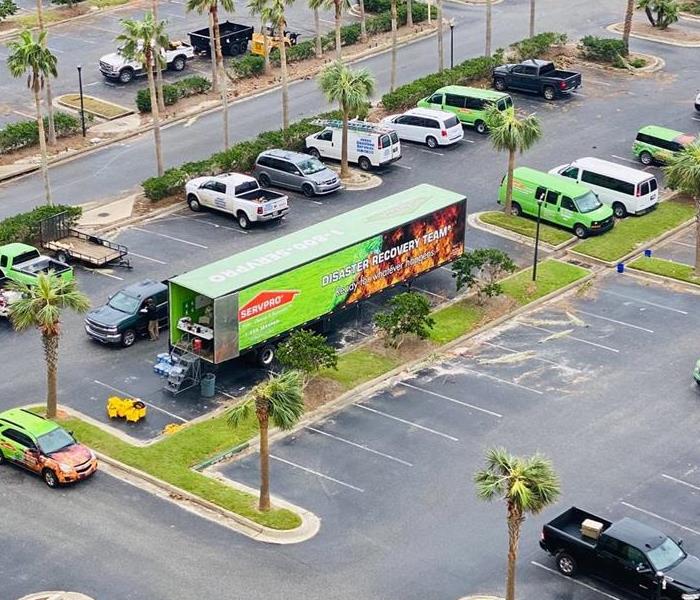 Following Hurricane Sally, we along with our franchise partners performed several large loss restoration projects along the Alabama Gulf Coast.
Following Hurricane Sally, we along with our franchise partners performed several large loss restoration projects along the Alabama Gulf Coast.
We frequently receive questions from clients who manage or on the board of condominium associations about how they can be prepared for tropical storms and hurricanes in order to make the restoration process as seamless and easy as possible.
While each condominium association is unique, there are two tips that apply to all associations, no matter the association's location or budget.
TIPS
- Choose your restoration vendor ahead of time.
- Resources are always limited after a hurricane or major disaster. By choosing your vendor ahead of time, you give your vendor the opportunity to allocate resources for your building(s) in the event of a damage.
- Allow your vendor to discuss the restoration process with key board members.
- Educating your board and staff beforehand will provide them with confidence and knowledge, and setup realistic expectations of the standards and practices of the insurance restoration process following a large loss. A hurricane is unlikely to happen every year, and with the changing of board members, it would be a good practice to invite your vendor to your annual meeting in order to keep the current board educated.
CHOOSE SERVPRO of Baldwin County
As leaders in the storm and water damage industry, we have advanced training and expertise as well as a tremendous amount of hands-on experience. We are a local company with national resources, and have access to the resources and personnel of 1,700 franchise partners to handle major storms and catastrophic disasters. If your association has storm damage, choose SERVPRO of Baldwin County: 251-928-9625.
Storm Damage?
10/28/2021 (Permalink)
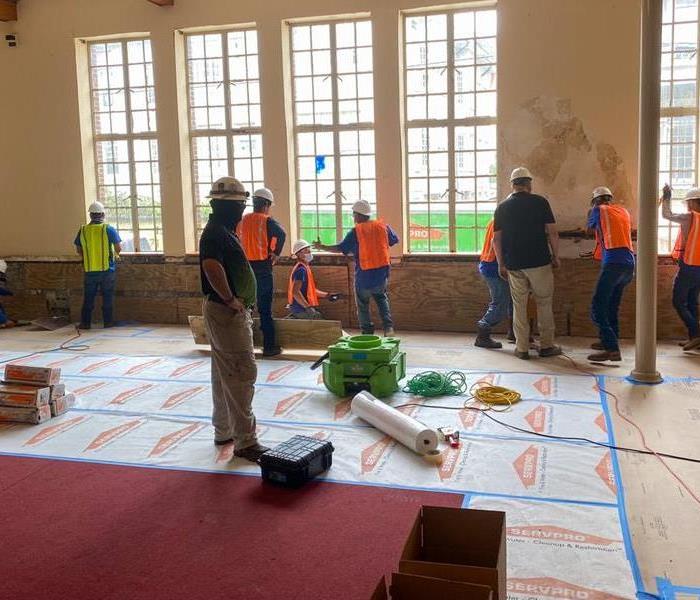 Our team is performing mitigation in this church following damage from a hurricane.
Our team is performing mitigation in this church following damage from a hurricane.
Storm damage may seem like an umbrella term, but it is one that we often hear living on the Gulf Coast. Storm damage from a hurricane could mean a variety of things. It could mean wind damage which could cause anything from fallen trees or powerlines onto your property, roof leaks, or wind-driven rain through windows and doors. It could also mean flooding caused by storm surge or ground water and excessive rains. Often times, especially near the coastline, storm damage means a combination of these items. If you live along the Gulf Coast or in any area that is prone to hurricanes, it is especially important to make sure that your business and home have adequate insurance coverage so that you can rest assured you are covered before disaster strikes.
CHOOSE SERVPRO
Our team at SERVPRO of Baldwin County is no stranger to the aftermath of hurricanes and storm events. We have seen our share of tropical storms and hurricanes both at home and away assisting franchise partners. Our resources, relationships, and years of experience have given us the tools to always be able to rise to the occasion in assisting our community. When disaster strikes, remember that your local team at SERVPRO of Baldwin County is always here to help.
2021 Hurricane Season
5/26/2021 (Permalink)
As we get ready to enter into hurricane season, we want to make sure our community is well prepared and informed of what to do in case the storms get way out of hand. To ensure you and your loved ones are safe during this upcoming storm season, read along for these tips on what to do to be storm safe:
- Know Your Risks: One the most important things you can do is understand how susceptible your area is to hurricane weather. Being informed of the likelihood of how a hurricane can affect your area by keeping up to date with weather announcement and local and governments
- Build an Emergency Kit: This one sounds simple, but it is often overlooked. Keeping an emergency kit that is stocked with water, canned foods, non perishables, and comfort items such as blankets and toys could be the difference between a disaster and an inconvenience.
- Review And Gather Documents: Review your policies ahead of time to see what is covered and if flood insurance is available to you. Gather important documents such as insurance policies, IDs, birth certificates, deeds, or even sentimental documents and keep them in a fireproof and waterproof safe.
- Be Informed: Knowing where to go and who to call is key to staying safe. Having an evacuation plan in place in the event of a disaster ensure members of your household know what to do in case home isn’t the safest place to be. Have a planned route and an alternate route to get to a safe place away from the storm.
- Strengthen Your Home: Taking a look around your property to see if you are vulnerable in the event of a hurricane is a key factor in minimizing your risk of damage. By looking for vulnerable areas, you’ll be able to address them and fortify and susceptible areas around the home or property.
Implementing these tips will help you face this hurricane season and minimize the risk of your property being a victim of the elements. Keep SERVPRO of Baldwin County in mind for all your storm damage restoration needs.
Surviving the Flood
5/26/2021 (Permalink)
We live in a world where mother nature has a mind of her own at times, and natural disaster can strike at anytime and can ruin the normal flow of life we once had. The nice furniture, flooring, and decor that once occupied our home, now washed away by water. Whether the flooding that has occurred in your home was because of a pipe bursting, a sewer backup, faulty appliance, a heavy rain or even rising floodwaters, there are important steps you should take in order to keep you and your family safe.
After any water damage situation, your primary focus should be safety:
- Is it safe to stay in the house?
- Electrical and "slip and fall" hazards are some of the most prevalent concerns.
- Only do activities that are safe for you to perform.
- Wet materials can be VERY heavy. Be careful!
You and your family may not even be thinking about flooding, but rather tornado damage or hurricane damage. But with any severe storm or rain there is always a chance of flooding. And even appliances can cause flooding. Here at SERVPRO® of Baldwin County we want you to be as prepared and safe as possible, therefore we put together some do and don'ts to put into practice after you have encountered flooding within your home.
What To Do After Flooding
- Remove excess water by mopping and blotting.
- Wipe excess water from wood furniture after removal of lamps and tabletop items.
- Remove and prop wet upholstery and cushions.
- Place aluminum foil or wood blocks between furniture legs and wet carpeting.
- Turn air conditioning on for maximum drying in summer.
- Remove colored rugs from wet carpeting.
- Remove art objects to a safe, dry place.
- Gather loose items from floors.
What NOT To Do After Flooding
- Don't leave wet fabrics in place. Hang furs and leather goods.
- Don't leave books, magazines or other colored items on wet carpet or floors.
- Don't use your household vacuum to remove water.
- Don't use television or other household appliances.
- Don't turn on ceiling fixtures if ceiling is wet, and keep out of rooms where ceilings are sagging.
Reminders:
- Do not panic, take a breath and understand that although today feels like the worst day ever. Things WILL get better.
- Keep safety always at the forefront of your mind (stop the water source, shut all electricity off, etc.)
- Call SERVPRO in order to get things clean, dry and back to beautiful as quickly as possible.
Why SERVPRO?
- 24-Hour Emergency Service
- Faster to Any Size Disaster
- Highly Trained Water Restoration Technicians
- A Trusted Leader in the Water Restoration Industry
- Locally Owned and Operated
- Advanced Water Inspection, Extraction, and Drying Equipment
Tips for Keeping Your Home Dry During Heavy Rain
4/21/2021 (Permalink)
Water damage can happen to your home in a variety of ways. Many homeowners (including some here in Baldwin County) think that only severe storms and floods or a major appliance malfunction involving your washing machine or dishwasher cause water damage.
But heavy rains are a significant water damage threat, too. These drenching storms frequently happen in our area during the spring and summer months. If your home is not prepared, these storms can cause costly damage.
Water Damage Is Common
Millions of Americans file claims to repair home water damage every year. Insurance industry experts estimate that as many as one out of every 50 homeowners will file a water damage claim this year.
Depending on how many people live in your neighborhood, that can mean someone you know will have to deal with water damage this year.
Homeowners can’t always avoid water damage. For example, severe storms, tornadoes and hurricanes can cause significant damage to many homes in the community. And homeowners can’t avoid these natural disasters.
But sometimes more common problems, namely heavy rains, can cause water damage to your home. Homeowners can avoid this type of damage if they ensure your home is well-maintained.
Getting Ready for Wet Weather
Our teams are prepared to help homeowners repair water damage. We’re experts, and that means we see many of the issues that cause the damage in the first place.
Because we know how the damage happens, we’ve put together some ideas to help you avoid it:
Check your yard. Knowing how your yard drains is vital to protecting your home. If you notice that your yard is draining toward your home, then you might want to connect with a landscaping expert to look for ways to protect your yard.
Choose the right type of landscaping. Many people choose plants and flowers for aesthetic effect. But choosing landscaping items carefully can ensure your home is prepared for heavy rains. Native plants, trees and bushes can be vital in protecting your home from water damage. Talk with landscaping experts in the area or visit a native plant sale for tips and ideas.
Look into sealing your roof. Experts estimate that almost 95% of damage is caused by water finding its way through gaps in your shingles, which can be prevented with this step. It’s definitely worth considering.
If you need help dealing with damage caused by water, fire or any other issue, we’re here to help you restore your home. We have crews who are available 24⁄7 in the event of an emergency. Contact us at any time to learn more about us and how we can help you restore your home to its original state. Serving all of Baldwin County here on the Alabama Gulf Coast. Call us at 251-928-9625
Did a Recent Gulf Coast Storm Cause Flood Damage?
4/21/2021 (Permalink)
SERVPRO is Here for Help With Flood Damage and Restoration – Crews are Available 24/7 in Baldwin County.
Flood Damage is No Match for SERVPRO – Call Us When You Need Prompt Flood Restoration Services
For emergency services water damage assistance, SERVPRO can be at your Baldwin County property within hours to get to work. Whether you need flooding cleanup or help with a leaking roof from storms, we have the proven methods and all of the best equipment for the job.
We bring industrial-grade equipment to help us achieve our cleanup goals when you call us for flood damage after a storm. Some of this equipment includes:
• Extraction Units – including large truck-mounted or portable units
• Light Wands – also known as carpet wands
• Deep Extraction Tools – including self-propelled extractors and stationary tools
• Pumps – including high-pressure pumps, self-priming trash pumps, and electric submersible pumps
SERVPRO of Baldwin County is available for all your needs regarding flood damage and water damage repairs after a storm. Call us at 251-928-9625.
National Preparedness Month: Week 3
9/14/2020 (Permalink)
September: National Preparedness Month
Week #3 – September 13th-19th, Goal: Educate Yourself About Disasters and Emergencies
Different areas have different threats for natural disasters, along with non-natural disasters. For this week of National Preparedness Month, take the list of disasters you may experience, and visit www.ready.gov/be-informed to learn more about each one. Each of these emergencies are covered in depth through ready.com: household chemical emergencies, hurricanes, landslides & debris flow, nuclear power plants, pandemic, power outages, radiological dispersion device, severe weather, snowstorms & extreme cold, space weather, thunderstorms & lightning, tornadoes, tsunamis, volcanoes, wildfires, active shooter, attacks in public places, avalanches, bioterrorism, chemical emergencies, cybersecurity, drought, earthquakes, explosions, extreme heat, floods, hazardous materials incidents, and home fires.
There is also information about what you can do to recover from these disasters. Some of the subjects include how to get involved with the community, citizens corps, community emergency response team, talking to your neighborhood/neighbors about their plans, and lists of organizations active during disasters.
Other Resources for Your Use:
Parents of Young Children www.ready.gov/kids
Business Owners www.ready.gov/business.
National Preparedness Month: Week 1 & 2
9/11/2020 (Permalink)
Week #1 – September 1st-5th, Goal: Make A Plan.
The goal of this week can be accomplished in 4 simple steps.
Step #1- Put a Plan Together
Different areas of the county are more at risk for different types of natural disasters. Your first step to put together a plan is to assess what disasters are the most heavy in your area, and make a list. Once you have a list, it will then help you with the rest of the steps.
With your list in mind, ask yourself these questions.
•How will I receive emergency alerts and warnings?
•What is my shelter plan?
•What is my evacuation plan?
•What is my household communication plan?
•Do I need to update my emergency preparedness kit?
This will help you identify anything you may have forgotten, and help you find holes in your plan.
Step #2- Consider Specific Needs in Your Household
You can easily look up lists of items to have on hand in case of an emergency, but this step makes your supplies list specific to your family’s needs. Look at each member, and think of any daily items they may need that is not on the list. This can include the daily care of infants/small children, elderly family members, how each member communicates, pets, or anyone with specialized medical equipment or medicine. Having these items on hand is very important when disaster strikes, and you may not be able to easily obtain them.
Step #3- Fill Out a Family Emergency Plan
https://www.ready.gov/sites/default/files/2020-03/create-your-family-emergency-communication-plan.pdf
Above is the Family Emergency Plan that ready.gov has put out to use. Whether you choose to use this one or not, it is a great reference in what information to have!
Step #4- Practice Your Plan with Your Family/Household
Now that you have your plan started, practicing and running over this plan thoroughly will help you identify any other weaknesses. It may also help your family members feel safe and comfortable after discussing this hard topic, especially with small children. Making sure they feel fully prepared and safe is a great way to put their minds at ease!
Week #2 – September 6th-12th, Goal: Build A Kit
The goal of an emergency kit is to help your family survive without assistance for at least 3 days.
Basic Kit Items:
•Water (for each person)
•Food (for each person) Hand crank can opener
•Local maps
•Cell phone chargers & a backup, portable battery
•First aid kit
•Whistle
•Dust masks & cloth masks
•Battery operated radio and/or weather radio
•Flashlights
•Extra batteries
•Wipes
•Trash bags
•Wrench & pliers (for cutting off emergency lines)
•Plastic sheeting & duct tape
Additional items to consider including:
•Cash
•Sleeping bag or blanket for each person
•Complete change of clothing for each person (including shoes)
•Fire extinguisher
•Activities for any children
•Soap & hand sanitizer
•Matches (make sure to store in a waterproof container!)
•Personal hygiene products
•Disposable paper products
•Prescription & over the counter medication
•Contact lens solution (if applicable)
•Copies of important family documents, in waterproof container or saved electronically
•If applicable: formula, bottles, diapers, wipes & diaper rash cream
•If applicable: pet food & water
Maintaining Your Home Kit:
Now that your kit is stocked and ready to go, you will need to update it regularly. A good idea is to update the kit each time you take a look at your emergency plan you created last week. This ensures it is kept up to date, and all items are ready to be used at any time. This also gives you the chance to update any specific items. For example: if an infant no longer needs bottles, remove those items from the kit to save room. You may then need to add in some jars of baby food.
Other Kits:
Now that you are on a roll, consider making smaller kits for work, and to keep in your vehicle. These kits should be much smaller and are a lot easier to create.
Your Work Kit should prepare you to stay at work for at least 24 hours. Also include a comfortable pair of walking shoes in this kit, as you may not be wearing comfortable shoes at work when an emergency takes place.
Your Car Kit should always be in all cars you may have. This kit should include jumper cables, flares or reflective triangles, an ice scraper, extra cell phone charger (with car charger), blanket, map and cat litter or sand (to help you gain traction if stuck).
National Preparedness Month
9/9/2020 (Permalink)
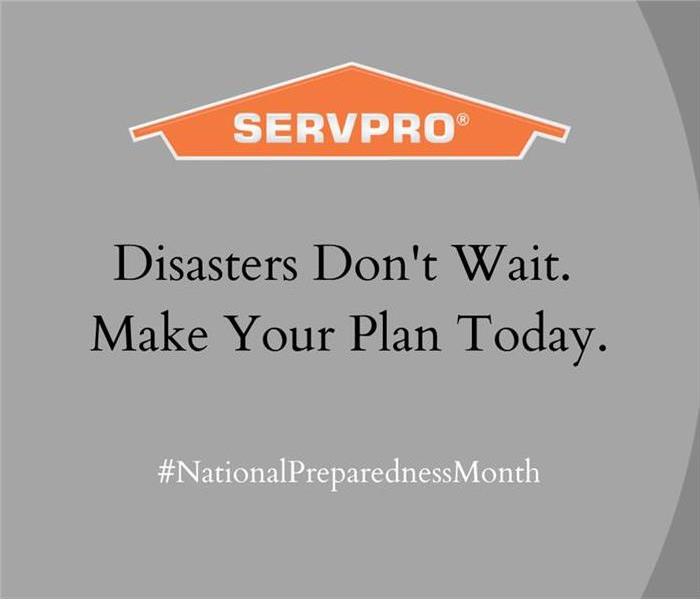 2020 National Preparedness Month
2020 National Preparedness Month
September is National Preparedness Month, recognized to promote community disaster planning. Preparing yourself, your loved ones, and your property for a disaster is crucial, especially in the unpredictable year of 2020. Ready.gov offers weekly National Preparedness Month themes to help organize your preparations:
Week 1 (September 1st-5th): Make a Plan
Determine lines of communication, designated meeting places in case of separation, and responsibilities for each member of your household. Depending on the needs of your family, you may require additional planning steps.
Week 2 (September 6th-12th): Build a Kit
Gather supplies for each member of your family. You kit may include food, clean water, medications, pet foods, communication devices, and batteries. Keep your kit as compact as possible, and in an easily accessible location, in case evacuation becomes necessary.
Week 3 (September 13th-19th): Prepare for Disaster
On the AL Gulf Coast, one of the most common disasters you may face is a hurricane. To prepare for such an event, be sure to follow local and national news as it pertains to hurricane tracking, check your insurance coverage, and make sure your disaster preparedness kit is built. If a storm is forecasted to hit in your area, follow the direction of local officials concerning shelter and evacuation orders.
Week 4 (September 20th-26th): Teach Youth About Preparedness
Make sure children’s needs are included in your preparations. Include their items in your disaster kit, talk with them about protocols and procedures in the event of a disaster situation, and answer any questions they may have.
As a leader in clean up and restoration, SERVPRO of Baldwin County is Here to Help in the event your property is damaged by a hurricane or other disaster situation. Our team is “Faster to Any Size Disaster!” To learn more about our services, call 251-928-9625.
For more information about National Preparedness Month, visit https://www.ready.gov/september
Hurricane Ready Kit
6/3/2020 (Permalink)
2020 Hurricane Season is here and we want to help you prepare NOW! After an emergency, you may need to survive on your own for several days. Being prepared means having your own food, water and other supplies to last for at least 72 hours. A disaster supplies kit is a collection of basic items your household may need in the event of an emergency.
Basic Disaster Supplies Kit
To assemble your kit store items in airtight plastic bags and put your entire disaster supplies kit in one or two easy-to-carry containers such as plastic bins or a duffel bag.
A basic emergency supply kit could include the following recommended items:
•Water (one gallon per person per day for at least three days, for drinking and sanitation)
•Food (at least a three-day supply of non-perishable food)
•Battery-powered or hand crank radio and a NOAA Weather Radio with tone alert
•Flashlight
•First aid kit
•Extra batteries
•Whistle (to signal for help)
•Dust mask (to help filter contaminated air)
•Plastic sheeting and duct tape (to shelter in place)
•Moist towelettes, garbage bags and plastic ties (for personal sanitation)
•Wrench or pliers (to turn off utilities)
•Manual can opener (for food)
•Local maps
•Cell phone with chargers and a backup battery
Source: https://www.ready.gov/kit
Protect your business from a storm
5/11/2020 (Permalink)
Have you taken steps to protect your business and employees on the Alabama Gulf Coast?
When we experience a thunderstorm in Baldwin County, it can potentially cause extensive damage to your business. Power outages downed tree limbs, and flooding from rainstorms are all possibilities. SERVPRO of Baldwin County has a few preventative steps you can take to ensure you are able to protect your business when these storms happen.
1. Keep Your Lightning Rod Maintained
A lightning rod is a metal rod mounted on a structure and intended to protect the structure from a lightning strike. If lightning hits the structure, it will preferentially strike the rod and be conducted to ground through a wire, instead of passing through the structure, where it could start a fire or cause electrocution. If your business is located in a tall building that may attract lightning, then maintaining the lightning rod can be essential. Have the rod checked annually for damage and ask your certification professionals to verify that it is up to code. If your business is located in an area where lightning is common, it is wise to have the unit cleaned and inspected at least twice a year.
2. Maintain All Trees on the Property High winds can turn tree limbs into projectiles that may shatter your building’s windows and cause serious injury to your customers or employees. Make sure you are maintaining your landscaping so dead branches do not detach and strike people entering your business below. Trimming trees away from your building’s power lines can protect its power source during a thunderstorm
3. Have a Flood Plan in Place Having a flood plan in place can possibly prevent flooding in your business, especially in the case of mitigation services. Contacting SERVPRO of Baldwin County before the wet season can be a wise choice because if your building should experience flooding, our team can have help on hand right away.
Protect your Gulf Coast Business from Storm Damage
4/25/2020 (Permalink)
As Baldwin County has been experiencing powerful storms, and 2020 Hurricane Season is nearing, we thought it’d be a good time to go over how to protect your property from water damage.
A flooded building can wreak havoc on your business operations and day to day life. If you are concerned about flood water, it is important to do what you can now so that your business property is better protected later. Here's how you can protect your property through this storm season.
Preparing Your Building
Before a flood even occurs, you can take steps to seal your building from water. Start by applying a waterproof coating to the exterior walls. Several other steps are also important.
" Install waterproof shields over windows and doors where possible.
" Strengthen walls to stand against the pressure of flood water or flood debris.
" Seal all areas where utilities enter the building.
" Anchor the building if necessary.
Protecting the Lower Levels
Inspect your first floor to ensure there are no areas where flood water can easily enter the premises. Regrade any land that slopes into your property, extend or redirect gutter spouts and repair any cracks in the walls. Move any valuable equipment or furniture to higher ground and create digital backups of any important paper documentation.
Taking Other Safety Measures
Water damage is not the only thing to worry about during flooding. It is also important to properly anchor any fuel tanks to prevent the water from sweeping them away, which can cause the lines to break and fires or explosions to happen. Sewer backflow valves are also important.
Preparing for Restoration
No matter how well you prepare your building for a flood, at least some damage is still likely to occur. Call a well-respected restoration company to help you remove moisture, dry materials and get your property ready to do business again.
Being 100 percent prepared for a natural disaster is practically impossible, but preparing now for a later storm means getting back into the swing of things as quickly as possible after any damage happens.
2020 Hurricane Season
4/24/2020 (Permalink)
How to Prepare for a Hurricane.
This 2020 Hurricane season is estimated to be more active than previous years. It's important to know what to do before it hits to help prevent damage or loss to your property.
List of Supplies
- An Emergency Readiness Plan for your family
- 3 days worth of water
- 3 days of non perishable food for each person or pet
- First Aid Kit
- Battery Powered Radio or radio alert
- Portable Power bank to charge cell phones
- Full Tank of Gas in car
- Batteries
- Whistle to Signal for Help
How to Prepare Your Home
- Cover your windows with storm shutter or plywood, or use tape the glass so the broken shards stay together
- Learn if you are in an area that floods, and how to properly sand bag your home
- Clean out your rain gutters
If you’ve already experienced flooding or storm damage, don’t hesitate to reach out to SERVPRO of Baldwin County 251-928-9625
Flood Damage Restoration For Your Baldwin County Home
4/20/2020 (Permalink)
As many people on the Alabama Gulf Coast know, flooding can easily disrupt a person’s everyday life and leave your home destroyed. If not appropriately resolved, water often causes severe damage that gets worse over time. Having the ability to restore water-damaged buildings is an invaluable service to both you and your insurance company.
Restoring water-damaged structures requires the Institute of Inspection Cleaning and Restoration Certification (IICRC) training, years of experience, and specialized equipment normally unavailable to your everyday homeowner.
SERVPRO of Baldwin County can help you understand the technical aspects of your flood damage restoration and provide you with the communication necessary to make the situation far less stressful.
At SERVPRO of Baldwin County, we use the IICRC’s Standard and Reference Guide for Professional Water Damage Restoration (S500). It presents us with a standard to adhere to when addressing flood damage in your home, with five fundamental principles.
• We provide health and safety procedures for workers and occupants.
• Document all conditions and work procedures.
• Perform damage mitigation to limit losses.
• Implement fast, efficient drying methods.
• Offer both cleaning and repair services.
SERVPRO of Baldwin County technicians provide customers with a quick response, 24-hours a day, 7-days a week, to prevent further damage. We address many dangers that exist concerning flood damage restoration that can injure you or even take your life. Our team looks for slip, trip, and fall hazards, chemical and environmental hazards, including hazardous materials, structural, and electrical.
Regardless of how secure you think you are, safety should always be your primary concern when dealing with flood damage restoration in your home. Water itself can be dangerous – often containing biohazards that you cannot recognize without special equipment. Always think about how long water remains in your home and the possibility of mold contamination.
If you need assistance, call SERVPRO of Baldwin County. We can help you with all types of flood damage, cleaning, and restoration services throughout the Alabama Gulf Coast area. We’re Faster to Any Size Disaster– call today 251-928-9625
Are You "Hurricane Ready"?
4/20/2020 (Permalink)
As 2020 Hurricane Season approaches, it is important to be prepared beforehand. Living on the Alabama Gulf Coast can be scary during hurricane season, as we experience several storms during these months. Hurricanes are massive storm systems that form over ocean water and often move toward land. Hurricanes include high winds, heavy rainfall, storm surge, coastal and inland flooding, rip currents and tornadoes all of which can destroy homes, buildings, and roads. It is important to stay ready so you do not find yourself scrambling to brace for the impact. There is always the potential looming that our area could be hit by a hurricane. Here are a few things to know ahead of a hurricane if one was to head our direction.
Know the Difference
•Flood/Flash Flood Watch—Flooding or flash flooding is possible in your area.
•Flood/Flash Flood Warning—Flooding or flash flooding is already occurring or will occur soon in your area.
How to Prepare
•Listen to area radio and television stations and a NOAA Weather Radio for possible flood warnings and reports of flooding in progress or other critical information from the National Weather Service (NWS).
•Be prepared to evacuate at a moment’s notice.
•When a flood or flash flood warning is issued for your area, head for higher ground and stay there.
•Because standard homeowners insurance doesn’t cover flooding, it’s important to have protection from the floods associated with hurricanes, tropical storms, heavy rains and other conditions that impact the U.S. For more information on flood insurance, please visit the National Flood Insurance Program Web site at www.FloodSmart.gov.
Different Types of Storm Damage
3/25/2020 (Permalink)
There are several types of storm damage including wind, flooding, or even fire. Flooding can cause extensive amounts of damage to your home, and lightning can create fires while high winds can cause many issues to the structure of your home.
Wind
The damage which results from extremely high winds is quite easy to see most of the time. Nowadays, roof shingles are designed better than their predecessors regarding their resistance to wind and the ever-increasing knowledge and standards. There is many times little can be done to prevent damage by wind in conditions that are very extreme. Roofs that are wind-damaged usually appear to be affected only in certain spots. The edges or perimeter of the room are affected by high winds easily, since the edge of a roof is quite prone to lifting.
Hail
Round dings in metal are clear signs of hail damage. Determining whether your roof has suffered damage from a hail storm, however, could be a bit more challenging. After hail hits the roof, it knocks off the protective granules where the hail has hit, and these areas of damage are the sources of leaks in the roof in the future if it is not fixed within a few years’ time.
Snow
Snow causes most of its damage from the weight of it, which immensely increases when ice, rain and sleet are added to it. On an average-sized roof, two feet of snow can weigh the equivalent of thirty-eight thousand pounds or nineteen tons. The obvious sign many times that a roof is about to fail is if it is sagging.
Ice
The functionality of a lot of gutter and roof systems are affected by the temperatures that fluctuate, making the snow melt then refreeze on the edge of the roof. This makes a dam which the water cannot pass through, meaning that as more snow melts off the roof and trickles down, it gets blocked by an ice dam and makes a puddle. Since roofs were not made to handle standing water, especially as the water line and growing puddle move up the roof, the water can seep through small openings in the roof into your home or attic.
Rain and Flood Damage
Water running out of a typical water drainage basin due to overflowing from a storm can wreak havoc on your property. Streams, creeks, rivers or lakes which overflow, flash floods, a storm surge or a tsunami are all examples of flood damage that are possible.
Flooding can cause damage to your property including your foundation and drywall damage. Most of the time the drywall will need to be removed and replaced. The flooding can also cause mold to grow on the property due to standing or hidden water, such as inside the walls. This should be taken care of as soon as possible, usually by a professional storm damage remediation company, as mold can cause a serious health risk to you and your family.
Call an Expert
At the first sign of damage contact a professional storm damage restoration company. We use specialized equipment and technology to tackle any storm damage to your property. We will be able to restore your property back to normal.
Contact SERVPRO of Baldwin County to restore your commercial or residential storm damage "Like it never even happened."
Business and Personal Preparedness
2/14/2020 (Permalink)
Business Preparedness: why and how you should prepare; and personal preparedness: how to pack your Go Bag and sheltering in place.
Up to 50% of businesses never reopen after being affected by a natural or human-made disaster. Despite this statistic, 62% of businesses don’t have an emergency plan in place! Your customers expect delivery of their products or services on time, regardless of your situation. And larger businesses want to insure that their supply chain is not interrupted by a disaster either. Insurance is only a partial solution. It does not cover all losses and it will NOT replace customers. News travels fast and perceptions often differ from reality. It is up to you to plan now for a disaster to avoid some of these pitfalls. Many risks cannot be insured, but some risks can be reduced by investing in loss prevention programs, protection systems, and equipment.
According to FEMA’s Business Program Management,” A preparedness policy that is consistent with the mission and vision of the business should be written and disseminated by management. The policy should define roles and responsibilities. It should authorize selected employees to develop the program and keep it current. The policy should also define the goals and objectives of the program. Typical goals of the preparedness program include:
- Protect the safety of employees, visitors, contractors and others at risk from hazards at the facility. Plan for persons with disabilities and functional needs.
- Maintain customer service by minimizing interruptions or disruptions of business operations
- Protect facilities, physical assets and electronic information
- Prevent environmental contamination
- Protect the organization’s brand, image and reputation
A word on environmental contamination—many times, smaller businesses without a plan in place will attempt to handle the work on their building on their own. Depending on the damage and the building in question, it may be safer and more cost effective to hire a professional company to help you. Why? Well, for starters, a cleanup company like SERVPRO of Baldwin County has the knowledge of environmental laws and regulations that you may be ignorant of. Our crew can dispose of potentially hazardous materials in a safe and compliant manner.
In order to prepare personally for a disaster, you should start by creating a Family Disaster Plan. To get started, contact your local emergency management office and your local chapter of the American Red Cross. Find out which disasters are likely to occur in your area by using the interactive map. Meet with your family and plan how you will stay in contact if separated by disaster. Because many disasters occur with little or no warning, you need to have a plan for what to do before you have instructions from authorities. Assess your situation. Decide to stay or change locations. If you are not in immediate danger, you should stay where you are and get more information before taking your next steps.
There are 3 types of sheltering, and different types are appropriate for different disasters. You can shelter in place, shelter for an extended stay, or enter a community shelter. When you shelter in place, you are sealing a room as a way to protect yourself from contaminants in the air for a short period of time. You should identify an internal room in your home or work, and store specific items such as snacks and water, a battery-operated radio, a flashlight, and pre-cut plastic sheeting and duct tape to seal off vents and doors and windows. If you are sheltering for an extended stay, you may need to store enough supplies for 2 weeks. If you are using a community shelter, you should bring your 3-day disaster supply kit with you.
So what goes in your kit? Depending on the length of time you will be gone, the time of year of the event, and how many people and pets you have with you, your kit might change. The items recommended for your basic kit are:
- 3 day supply of non-perishable food
- 3 day supply of water (one gallon per person per day)
- Portable, battery powered radio and extra batteries
- Flashlight and extra batteries
- First aid kit and manual.
- Sanitation and hygiene items (moist towelettes and toilet paper)
- Matches and waterproof container
- Whistle
- Extra clothing (think warmth if in a cold climate)
- Kitchen accessories and cooking utensils, including a can opener.
- Photocopies of credit and identification cards
- Cash and coins
- Special needs items, such as prescription medications, eyeglasses, and hearing aid batteries.
- Items for infants and items for pets.
Just as important as putting your supplies together is maintaining them so they are safe when you are ready to use them.
- Keep canned foods in a cool dry place.
- Store boxed food in tightly closed plastic or metal containers.
- Throw out any canned good that becomes swollen, dented, or corroded.
- Change stored food and water supplies every 6 months. Write the date on the containers.
- Keep items in airtight plastic bags and put your entire kit in one or two easy-to-carry containers.
- Re-think your needs every year and update your kit as your family needs change.
I recommend keeping a Go Bag in your car, and one in your house, as you will never know where you will be when a disaster hits. If you need help preparing your home or business for disasters, call us at 251-928-9625. We can help you create a plan for your building and tag your shut offs when necessary. And if something does go wrong, call us to help make it "Like it never even happened."
Hurricane Facts
2/13/2020 (Permalink)
- A hurricane is an intense tropical storm with powerful winds and rain.
Other names for a hurricane include cyclone, typhoon and tropical storm.
While they are essentially the same thing, the different names usually indicate where the storm took place. Tropical storms that form in the Atlantic or Northeast Pacific (near the United States) are called hurricanes, those that form near in the Northwest Pacific (near Japan) are called typhoons and those that form in the South Pacific or Indian oceans are called cyclones.
Hurricanes usually form in tropical areas of the world.
Hurricanes develop over warm water and use it as an energy source.
Hurricanes lose strength as they move over land.
Coastal regions are most at danger from hurricanes.
As well as violent winds and heavy rain, hurricanes can also create tornadoes, high waves and widespread flooding.
Hurricanes are regions of low atmospheric pressure (also known as a depression).
The wind flow of hurricanes in the southern hemisphere is clockwise while the wind flow of hurricanes in the northern hemisphere is counterclockwise.
Weather in the eye of a hurricane is usually calm.
The eye of a hurricane can be anywhere from 2 miles (3.2 kilometers) in diameter to over 200 miles (320 kilometers) but they are usually around 30 miles (48 kilometers).
The winds around the eye of a hurricane are usually the strongest.
Hurricanes can be tracked by weather satellites and weather radar closer to land.
Hurricanes have led to the death of around 2 million people over the last 200 years.
The 1970 Bhola Cyclone that struck Bangladesh killed over 300000 people.
In 2005 Hurricane Katrina killed over 1800 people in the United States and caused around $80 billion dollars worth of property damage. The city of New Orleans was hit particularly hard with levee breaches leading to around 80% of the city being flooded.
Tornado 101
2/13/2020 (Permalink)
What is a tornado?
A tornado is a narrow, violently rotating column of air that extends from the base of a thunderstorm to the ground. Because wind is invisible, it is hard to see a tornado unless it forms a condensation funnel made up of water droplets, dust and debris. Tornadoes are the most violent of all atmospheric storms.
Where do tornadoes occur?
Tornadoes occur in many parts of the world, including Australia, Europe, Africa, Asia, and South America. Even New Zealand reports about 20 tornadoes each year. Two of the highest concentrations of tornadoes outside the U.S. are Argentina and Bangladesh.
How many tornadoes occur in the U.S. each year?
About 1,200 tornadoes hit the U.S. yearly. Since official tornado records only date back to 1950, we do not know the actual average number of tornadoes that occur each year. Plus, tornado spotting and reporting methods have changed a lot over the last several decades.
Where is tornado alley?
Tornado Alley is a nickname invented by the media for a broad area of relatively high tornado occurrence in the central U.S. Various Tornado Alley maps look different because tornado occurrence can be measured many ways: by all tornadoes, tornado county-segments, strong and violent tornadoes only, and databases with different time periods. Please remember, violent or killer tornadoes do happen outside “Tornado Alley” every year.
When are tornadoes most likely?
Tornado season usually refers to the time of year the U.S. sees the most tornadoes. The peak “tornado season” for the Southern Plains is during May into early June. On the Gulf coast, it is earlier during the spring. In the northern plains and upper Midwest, tornado season is in June or July. But, remember, tornadoes can happen at any time of year. Tornadoes can also happen at any time of day or night, but most tornadoes occur between 4–9 p.m.
What is the difference between a Tornado WATCH and a Tornado WARNING?
A Tornado WATCH is issued by the NOAA Storm Prediction Center . Meteorologists who watch the weather 24/7 across the entire U.S. for weather conditions that are favorable for tornadoes. A watch can cover parts of a state or several states. Watch and prepare for severe weather and stay tuned to NOAA Weather Radio to know when warnings are issued.
A Tornado WARNING is issued by your local NOAA National Weather Service Forecast Office, meteorologists who watch the weather 24/7 over a designated area. This means a tornado has been reported by spotters or indicated by radar and there is a serious threat to life and property to those in the path of the tornado. ACT now to find safe shelter! A warning can cover parts of counties or several counties in the path of danger.
Content Credit: nssl.noaa.gov
Types of Storm Damage
2/12/2020 (Permalink)
Here are a few quick tips to consider should storm damage hit your home or commercial property.
Wind Damage Restoration
Hurricanes often cause severe wind damage. Your roof is particularly susceptible. Roof damage from strong winds may lift roof shingles, cause cracks, or remove part or all of the roof. Harsh winds and rains can shear away asphalt tiles. Flying debris can also cause cracks and holes in your roof and siding. Correcting roof damage may challenge homeowners and business owners after a disaster, especially because a roof leak may not be obvious.
Roof Leaks
Why are many roof leaks and roof damage hard to detect? The storm may loosen flashing without creating a problem that’s easily visible to the eye. Loose flashing can cause another roof leak even weeks after the initial storm damage. A small roof leak can produce damp, moldy conditions inside your home or business. You best bet is to secure roof repair immediately after the wind damage. Doing so can prevent long term interior damage. A wind damage restoration expert, like the professionals at SERVPRO of Baldwin County, will help assure the homeowner or business owner receives a comprehensive roof assessment and roof repair services when hurricane or wind damage hits.
Flood Damage & Recovery
If your home or business is near water or in a low-lying area, flood water damage is a risk. Heavy rains and flooding may cause water damage many miles from the coast or from any large body of water. If the land around your home or business cannot absorb the additional water flooding may happen. Even homes and businesses at higher elevations can sustain flood damage if frozen pipes break. Flood pump failures contribute to basement flooding and contaminated ground water too.
Flooding may also disrupt your municipal water system. Experts need to assess ground water and evaluate the condition of pipes following flood damage. Hiring a storm restoration professional, like SERVPRO of Baldwin County may allow you to begin your cleanup process even before water restoration occurs. And don’t forget-- cleaning before water restoration often proves essential yet challenging.
By relying upon a trained water damage restoration specialist, you'll usually obtain faster storm remediation. These experts may suggest ways to help mitigate flood water damage in the future, for instance, by requesting backup flood pump installation.
Hail Damage & Recovery
Hail may be the most overlooked cause of major storm damage. Hail can damage not just your roof but also your siding, exterior walls, and any detached sheds or outbuildings. You may think you’ve survived a hail storm but do know that hail damage is difficult to identify. Again, you’re wise to hire a storm damage restoration professional to inspect your roof, exterior walls, and outbuildings for damage. Dark spots on your roof are areas where the roofing granules have been knocked away. These weakened spots can lead to other more extensive problems such as leaks and cracks. Cracked and chipped siding is also a sign of hail damage.
Impact Damage & Recovery
In a major storm practically anything can become a creator of damage to your home or business. Think about trees. Your home may survive storm damage only to have a tree on your property succumb to the wind, hail, or rain and fall onto your house. A neighbor’s outdoor lawn furniture can become wind-blown projectiles. Extreme wind pressure turns regular outdoor items into tools of destruction. After storm damage, the professionals at SERVPRO of Baldwin County do a walk around to look for the signs of these types of unusual damage.
Help Is Here
The team at SERVPRO of Baldwin County has specialized training and experience in fire restoration services, natural disaster prevention, water damage, and natural disaster cleanup. Our staff is highly trained in building services and property damage restoration. We study IICRC standards and best practices in cleaning and restoration.
When Thunder Roars, Go Indoors
6/12/2019 (Permalink)
It’s that time of the year. Summer comes with rain. Rain comes with thunder storms and lightning. Lightning is a leading cause of injury and death from weather-related hazards. Although most lightning victims survive, people struck by lightning often report a variety of long-term, debilitating symptoms. Thunderstorms are dangerous storms that include lightning and can:
- Include powerful winds over 50 MPH;
- Create hail; and
- Cause flash flooding and tornadoes.
IF YOU ARE UNDER A THUNDERSTORM WARNING, FIND SAFE SHELTER RIGHT AWAY
- When thunder roars, go indoors!
- Move from outdoors into a building or car.
- Pay attention to alerts and warnings.
- Unplug appliances.
- Do not use landline phones.
HOW TO STAY SAFE WHEN A THUNDERSTORM THREATENS
WHAT TO DO NOW: Prepare
- Know your area’s risk for thunderstorms. In most places, they can occur year-round and at any hour.
- Sign up for your community’s warning system. The Emergency Alert System (EAS) and National Oceanic and Atmospheric Administration (NOAA) Weather Radio also provide emergency alerts.
- Identify nearby, sturdy buildings close to where you live, work, study, and play.
- Cut down or trim trees that may be in danger of falling on your home.
- Consider buying surge protectors, lightning rods, or a lightning protection system to protect your home, appliances, and electronic devices.
We Have the Resources to Handle Storms and Disasters
Have Storm or Flood Damage?
Call SERVPRO of Baldwin County today at 251-928-9625
Prepare for 2019 Hurricane Season
4/1/2019 (Permalink)
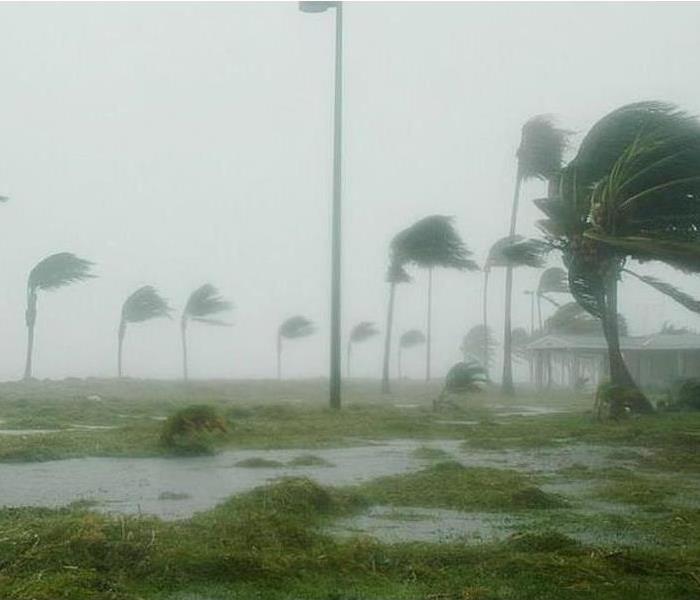 There were 15 named storms, eight hurricanes and two major hurricanes in 2018.
There were 15 named storms, eight hurricanes and two major hurricanes in 2018.
The Atlantic hurricane season officially runs from June 1 to Nov. 30.
The 2018 Atlantic hurricane season will officially go in the books as being a bit “above normal.”Of course, if a hurricane hit where you live, it was far from an average year. Just ask the folks in the Florida panhandle and the Carolinas. With its 15 named storms, eight hurricanes and two major hurricanes, 2018 matched the early predictions from the National Oceanic and Atmospheric Administration, or NOAA.
The agency forecast 10 to 16 named storms, including five to nine hurricanes, and one to four major hurricanes with Category 3 strength or higher, back in May before the season started.
An average six-month Atlantic season typically produces 12 named storms, of which six become hurricanes. including three major hurricanes. The 2018 season was defined by two powerful storms that formed in its second half - Hurricanes Florence and Michael.
Florence got its start on Sept. 1 as a tropical storm that formed just off the coast of West Africa.On its nearly two-week trek across the Atlantic, Florence strengthened to a Category 4 storm before making landfall near Wrightsville Beach, NC, as a Category 1 hurricane with maximum sustained winds of 90 mph.The rain from the system soaked the region, dumping nearly 40 inches of rain in Elizabethtown, NC, causing widespread flooding that took weeks to recede.At least 55 deaths were attributed to the storm. Property damage and economic losses in North and South Carolina approached $18 billion.
Hurricane Michael took a different path, forming Oct. 7 near the Yucatan Peninsula, where the Caribbean and Gulf of Mexico meet.Four days later, Michael made landfall as a Category 4 hurricane in the Florida Panhandle. The storm’s 155 mph winds made Michael the strongest storm to hit the continental U.S. since Hurricane Andrew in 1992. More than one million people, across four states, were left without power due to Michael.
The storm killed at least 43 people in Florida and 10 more in Georgia, North Carolina and Virginia. Of those, 21 were in Florida’s Bay County, where the hurricane made landfall, nearly wiping out Mexico Beach. Michael caused more than $14 billion in damages.
http://www.wsfa.com/2018/11/29/atlantic-hurricane-season-year-florence-michael/
How can you be prepared?
Speak with your insurance agent regarding your coverage. Flood insurance and Hurricane/Wind insurance may not be included in your Homeowners policy.
Speak with your insurance agent regarding what amount will allow you the ability to rebuild your home. A lower premium is not always best if it does not cover the costs to rebuild. It's important to have enough coverage!
Review your policies before Hurricane season (reminder: it starts June 1st!) with your insurance agent. There is a 30-day waiting period before flood insurance goes into effect. Some times, insurers will not adjust your coverage after a storm is forecast.
See this post for information on how you can prepare your family in case of evacuation due to flooding.
Floods
2/26/2019 (Permalink)
Floods
Failing to evacuate flooded areas, entering flood waters, or remaining after a flood has passed can result in injury or death. Flooding is a temporary overflow of water onto land that is normally dry. Floods are the most common natural disaster in the United States. Floods may:
Result from rain, snow, coastal storms, storm surges, and overflows of dams and other water systems.
Develop slowly or quickly – Flash floods can come with no warning.
Cause outages, disrupt transportation, damage buildings, and create landslides.
IF YOU ARE UNDER A FLOOD WARNING, FIND SAFE SHELTER RIGHT AWAY
Do not walk, swim, or drive through flood waters. Turn Around, Don’t Drown!
(Just six inches of moving water can knock you down, and one foot of moving water can sweep your vehicle away.)
Stay off of bridges over fast-moving water.
Determine how best to protect yourself based on the type of flooding.
HOW TO STAY SAFE WHEN A FLOOD THREATENS
Prepare NOW
Know types of flood risk in your area. Visit FEMA’s Flood Map Service Center for information.
Sign up for your community’s warning system. The Emergency Alert System (EAS) and National Oceanic and Atmospheric Administration (NOAA) Weather Radio also provide emergency alerts.
If flash flooding is a risk in your location, then monitor potential signs, such as heavy rain.
Learn and practice evacuation routes, shelter plans, and flash flood response.
Gather supplies in case you have to leave immediately, or if services are cut off. Keep in mind each person’s specific needs, including medication. Don’t forget the needs of pets. Obtain extra batteries and charging devices for phones and other critical equipment.
Purchase or renew a flood insurance policy. It typically takes up to 30 days for a policy to go into effect and can protect the life you've built. Homeowner’s policies do not cover flooding. Get flood coverage under the National Flood Insurance Program (NFIP)
Keep important documents in a waterproof container. Create password-protected digital copies.
Protect your property. Move valuables to higher levels. Declutter drains and gutters. Install check valves. Consider a sump pump with a battery.
https://www.ready.gov/floods
Thunderstorms & Lightning
2/26/2019 (Permalink)
Lightning is a leading cause of injury and death from weather-related hazards. Although most lightning victims survive, people struck by lightning often report a variety of long-term, debilitating symptoms. Thunderstorms are dangerous storms that include lightning and can:
IF YOU ARE UNDER A THUNDERSTORM WARNING, FIND SAFE SHELTER RIGHT AWAY
When thunder roars, go indoors!
Move from outdoors into a building or car.
Pay attention to alerts and warnings.
Unplug appliances.
Do not use landline phones.
HOW TO STAY SAFE WHEN A THUNDERSTORM THREATENS
Prepare NOW
Know your area’s risk for thunderstorms. In most places, they can occur year-round and at any hour.
Sign up for your community’s warning system. The Emergency Alert System (EAS) and National Oceanic and Atmospheric Administration (NOAA) Weather Radio also provide emergency alerts.
Identify nearby, sturdy buildings close to where you live, work, study, and play.
Cut down or trim trees that may be in danger of falling on your home.
Consider buying surge protectors, lightning rods, or a lightning protection system to protect your home, appliances, and electronic devices.
https://www.ready.gov/thunderstorms-lightning






 24/7 Emergency Service
24/7 Emergency Service



